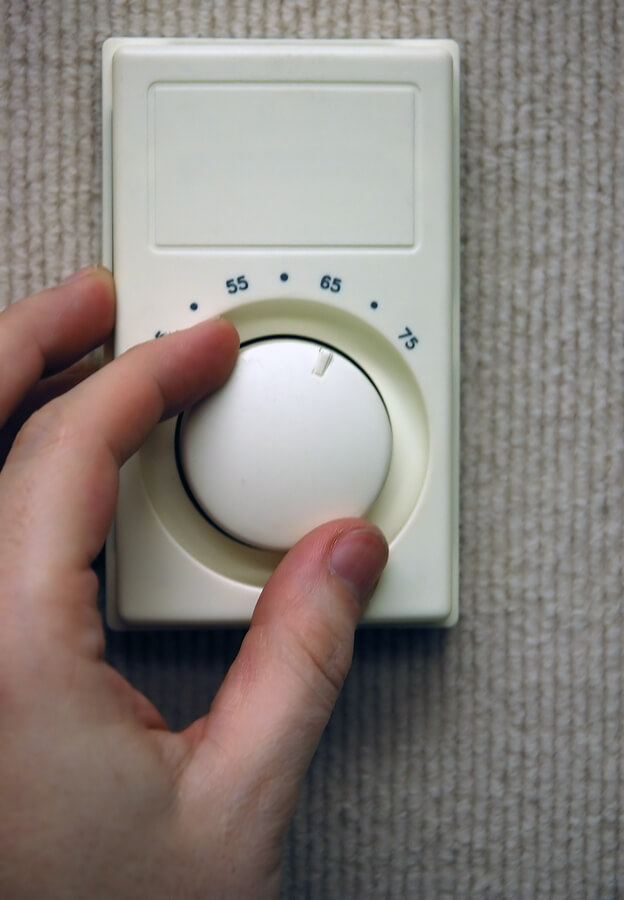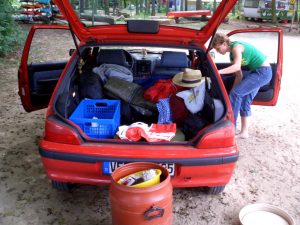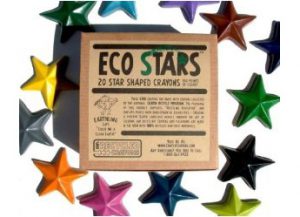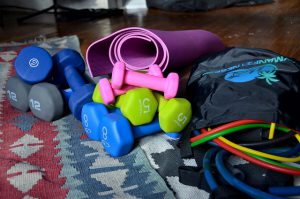
Turn Down Your Thermostat

Turn Down Your Thermostat
For every degree you lower your thermostat in the 60-70 degree range, you save about 5% on heating costs. Set your thermostat to 68 degrees or lower during the day and evening, and 55 degrees at night and when you are leaving home for an extended amount of time. By setting the thermostat lower while sleeping or away, you can save anywhere from 5-20% on heating costs. Along the same lines, lower your hot water temperature. Set the water heater to the normal setting, or 120 degrees Fahrenheit. (Check the owner’s manual for your dishwasher to see whether it requires a higher setting.)
Conserve Water

Conserve Water
Aim to take shorter showers, since cutting your shower time in half can reduce your water costs by 33%. Run the dishwasher only when it is full. When it’s time to replace your clothes washer, consider buying a front loader machine. Also, when doing laundry, set the water temperature to cold. Unless your clothing has oily stains on it, cold water will wash them just as well as hot water. Using a cold water detergent will also help get clothes clean.
Give Your Furnace a Tune-up

Give Your Furnace a Tune-up
Dirty filters in furnaces can restrict airflow and increase energy use. If you replace or clean your furnace filters once a month and keep your furnace lubricated and properly adjusted, you can save up to 5% on heating costs.
Seal Leaks

Seal Leaks
Caulk any leaks in your house, especially around windows and doors. Check areas on walls surrounding pipes or vents, and caulk any gaps. For jobs where caulking isn’t enough, hardware stores have products to close up larger gaps. Make sure you check every room in your house, as well as inside any closets that have pipes going through them. Other areas to check include dropped ceilings, recessed lights, the attic entrance, sill plates, water and furnace flues, and electrical outlets and switches.
Insulate

Insulate
Check the insulation in your attic, ceilings, basement walls, floors, and crawl spaces, especially if you live in an older home. Only 20% of homes built before 1980 are well insulated. Adding insulation will help create a more uniform temperature in your house, and will make it more comfortable during the winter months. Adding insulation to the attic is one of the most cost-effective ways to make your house more comfortable year round, both in the winter cold and the summer heat.
Repair and Insulate Your Ducts and Pipes

Repair and Insulate Your Ducts and Pipes
Your ducts (the network of tubes in your walls, floors, and ceilings) carry the air from your furnace to every room in your house. Most duct systems are poorly insulated, resulting in a heat loss of up to 60% and hundreds of wasted dollars every year for most households. Leaks in ducts end up heating areas of the house such as the attic and crawl spaces – areas nobody occupies! Check your ducts for air leaks: Look for separations in sections that should be joined, and sections that have obvious holes. If you are going to use tape to seal your ducts, be sure to avoid using cloth-based, rubber adhesive duct tape, since this tends to fail quickly. Instead, try using mastic, butyl tape, foil tape, or tape that carries the Underwriters Laboratories logo. Minor duct repairs are easy to make, but ducts in unventilated areas of the house should be sealed and insulated by a trained professional with the appropriate materials. You should also insulate the first five feet of pipe coming out of the top of your water heater, to reduce heat loss. Pipe insulation is available at any hardware store. Don’t forget to install a carbon monoxide (CO) detector that will alert you to harmful levels of CO, especially if you have a fuel-burning furnace, stove, or other appliance, or if you have an attached garage.
Winterize Your Windows

Winterize Your Windows
Drafty windows can add 10-20% to your heating bill. If your home has single-paned windows, as most U.S. homes do, you may want to consider replacing them with double-sided panes. New windows on the market are gas-filled with low emissivity (low-e) to help reduce air loss. Also, installing interior or exterior storm windows can reduce heat loss by 25-50%. Although replacing windows is pricey, you’ll save bundles of cash in the long term. If replacing your windows is out of the question, there are other steps you can take. Attach a heavy-duty, clear plastic sheet over the window frames, or tape clear plastic film to the insides of window frames to help keep warm air from leaking out. Try installing tight-fitting, insulated window shades on any windows that still feel drafty after they have been weatherized. Keep the shades on the south-facing sides of your house open during the day to allow sunlight in, and close them at night to keep out any chill. Just keeping your windows clean will help let more sunlight in, therefore increasing the warmth from solar gain.
Close Your Fireplace’s Damper

Close Your Fireplace’s Damper
Traditional fireplaces actually lose energy, since they pull warm air up the chimney and out of the house. When the fireplace isn’t in use, make sure you close the damper — but first ensure there aren’t any smoldering embers lingering. If you decide not to use the fireplace at all, block the chimney off with a piece of rigid insulation that fits snugly into place. This type of insulation can be found at any hardware store.
Revamp Your Indoor Lighting

Revamp Your Indoor Lighting
About 11% of the energy bill in an average household is from lighting. Shorter days and more time spent indoors mean you will be turning on more lights inside your home. Switch from incandescent light bulbs to compact fluorescent light bulbs. CFL bulbs use 75% less energy than incandescent bulbs, and last up to 10 times longer. Turn off the lights whenever you leave a room, even if you will only be gone for a short amount of time. You might consider installing a timer or occupancy sensor to reduce the amount of time your lights are on. Also, try task lighting – instead of lighting up an entire room, use a light that focuses only on the area you are working in.
Minimize Gas Use

Minimize Gas Use
Energy waste occurs outside the home, as well. Letting your car idle for long periods of time gets you 0 miles per gallon and wastes fuel. The best way to warm up your car in the winter months is to drive it. Thirty seconds is all you need to idle; anything more than that just wastes gas and increases emissions. Aggressive driving, such as speeding, hard braking, and accelerating quickly, can lower gas mileage up to 33% on the highway, and 5% when driving in the city. Speeding is a particularly big energy waster. If you cut your speed from 75 mph to 65 mph, you can burn up to 15% less fuel. Using overdrive will also slow down your car’s engine, which saves gas and helps cut down on wear. Other tips to improve your gas mileage include the following:
Use the grade of motor oil recommended by your car’s manufacturer. Using a different kind can cut your gas mileage by 1-2%.
Keep your tires properly inflated and aligned, to improve your gas mileage by about 3%.
Replace any clogged air filters to improve gas mileage by up to 10%, as well as help protect your engine.





